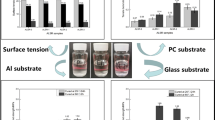Abstract
Extremely strong reinforced adhesion between a polytetrafluoroethylene (PTFE) film and butyl rubber is achieved using an atmospheric pressure plasma graft polymerization, involving argon and acrylic acid vapor. The treated PTFE film is then placed over a raw butyl rubber plate and hot-pressed under 157 N/cm2 for 40 min at 150 °C or for 10 min at 180 °C. This procedure results in molecular-level or chemical adhesion between the butyl rubber and the PTFE film. The 180° peeling test results show that a high peeling strength of 3.9 N, per 1 mm sample width, is achieved. Adherend failure of the rubber sheet occurs when the peeling is enforced. From X-ray photoelectron spectroscopy analysis of the treated films, chemical bonds with fluorine atoms are absent from the surface. From scanning electron microscopy analysis, a transparent hydrophilic poly(acrylic acid) layer composed of nanoscale spherical particles is formed. This PTFE-rubber composite material is suitable for high-quality, prefilled medical syringe gaskets.














Similar content being viewed by others
References
Okubo M, Tahara M, Saeki N, Yamamoto T (2008) Surface modification of fluorocarbon polymer films for improved adhesion using atmospheric-pressure nonthermal plasma graft-polymerization. Thin Solid Films 516:6592–6659
Kuroki T, Tahara M, Kuwahara T, Okubo M (2014) Microfabrication and metal plating technologies on polytetrafluoroethylene film surface treated by atmospheric-pressure nonthermal-plasma graft polymerization process. IEEE Trans Ind Appl 50:45–50
Kuroki T, Nakayama K, Nakamura D, Onji T, Okubo M (2015) Nonthermal plasma hybrid process for preparation of organic electro-luminescence fluoropolymer film devices. IEEE Trans Ind Appl 51:2497–2503
Lappan U, Buchhammer HM, Lunkwitz K (1999) Surface modification of poly(tetrafluoroethylene) by plasma pretreatment and adsorption of polyelectrolytes. Polymer 40:4087–4091
Inagaki N, Yasuda H (1981) Adhesion of glow discharge polymers to metals and polymers. J Appl Polym Sci 26:3333–3341
Tahara M, Cuong NK, Nakashima Y (2003) Improvement in adhesion of polyethylene by glow-discharge plasma. Surf Coat Technol 174–175:826–830
Shimizu K, Umeda A, Blajan M (2011) Surface treatment of polymer film by atmospheric pulsed microplasma: study on gas humidity effect for improving the hydrophilic property. Jpn J Appl Phys 50:08KA03-1–08KA03-5
Iriyama Y, Mochizuki T, Watanabe M, Utada M (2002) Plasma treatment of silk fabrics for better dyeability. J Photopolym Sci Technol 15:299–306
Roth JR (2001) Industrial plasma engineering, application to nonthermal plasma processing. Inst Phys Publ 2:383
Yamamoto T, Yoshizaki A, Kuroki T, Okubo M (2004) Aluminum surface treatment using three different plasma-assisted dry chemical processes. IEEE Trans Ind Appl 40:1220–1225
Yamamoto T, Okubo M, Imai N, Mori Y (2004) Improvement on hydrophilic and hydrophobic properties of glass surface treated by nonthermal plasma induced by silent corona discharge. Plasma Chem Plasma Process 24:1–12
Okubo M, Saeki N, Yamamoto T (2008) Development of functional sportswear for controlling moisture and odor prepared by atmospheric pressure nonthermal plasma graft polymerization induced by RF glow discharge. J Electrost 66:381–387
Cernáková L, Kovácik D, Zahoranová A, Cernák M, Mazúr M (2005) Surface modification of polypropylene non-woven fabrics by atmospheric-pressure plasma activation followed by acrylic acid grafting. Plasma Chem Plasma Process 25:427–437
König U, Nitschke M, Menning A, Eberth G, Pilz M, Arnhold C, Simon F, Adam G, Werner C (2002) Durable surface modification of poly(tetrafluoroethylene) by low pressure H2O plasma treatment followed by acrylic acid graft polymerization. Colloids Surf B Biointerfaces 24:63–71
Okubo M, Tahara M, Kuroki T, Hibimo T, Saeki N (2008) Plating technology for fluorocarbon polymer films using atmospheric-pressure nonthermal plasma graft polymerization. J Photopolym Sci Technol 21:219–224
Desmet T, Morent R, De Geyter N, Leys C, Schacht E, Dubruel P (2009) Nonthermal plasma technology as a versatile strategy for polymeric biomaterials surface modification: a review. Biomacromolecules 10:2351–2378
Boschet F, Ameduri B (2014) (Co)polymers of chlorotrifluoroethylene: synthesis, properties, and applications. Chem Rev 114:927–980
Zanini S, Orlandi M, Colombo C, Grimoldi E, Riccardi C (2009) Plasma-induced graft-polymerization of polyethylene glycol acrylate on polypropylene substrates. Eur Phys J D 54:159–164
Jafari R, Asadollahi S, Farzaneh M (2013) Applications of plasma technology in development of superhydrophobic surfaces. Plasma Chem Plasma Process 33:177–200
Feng Z, Saeki N, Kuroki T, Tahara M, Okubo M (2012) Surface modification by nonthermal plasma induced by using magnetic-field-assisted gliding arc discharge. Appl Phys Lett 101:041602
Gao SH, Zhou KS, Lei MK, Wen LS (2008) Surface modification of silicone rubber by CF4 radio frequency plasma immersion. Plasma Chem Plasma Process 28:715–728
Okubo M, Tahara M, Aburatani Y, Kuroki T, Hibino T (2010) Preparation of PTFE film with adhesive surface treated by atmospheric-pressure nonthermal plasma graft polymerization. IEEE Trans Ind Appl 46:1715–1721
Shiki H, Motoki J, Ito Y, Takikawa H, Ootsuka T, Okawa T, Yamanaka S, Usuki E, Nishimura Y, Hishida S, Sakakibara T (2008) Development of split Gliding arc for surface treatment of conductive material. Thin Solid Films 516:3684–3689
Sulfur Chemical Laboratory Inc. http://scl-inc.jp (in Japanese)
Mori K (1988) Functionalization of metal surfaces by triazine thiols. Jitsumu Hyomen Gijyutsu 35:210–218 (in Japanese)
Takagi K, Hirahara H, Mori K, Eiichi Narita E, Oishi Y, Mori K (2008) Direct adhesion of silicone rubber resins during peroxide curing using molecular adhesive. Nihon Gomu Kyokai-Shi 81:18–23 (in Japanese)
Sang J, Aisawa S, Hirahara H, Mori K (2016) Primary process to fabricate functional groups on acrylonitrile-butadiene rubber surface during peroxide curing. Chem Eng J 287:657–664
Acknowledgments
The authors are grateful to Dr. Zong-Bao Feng (Formerly a researcher of Osaka Prefecture University, currently Token Thermo Tech Co., Ltd.) and Mr. Ken Nakayama (graduate student of Osaka Prefecture University) for their help in the experiments. This study is supported in part by JSPS KAKENHI Grant No. 15K13932.
Author information
Authors and Affiliations
Corresponding author
Rights and permissions
About this article
Cite this article
Okubo, M., Onji, T., Kuroki, T. et al. Molecular-Level Reinforced Adhesion Between Rubber and PTFE Film Treated by Atmospheric Plasma Polymerization. Plasma Chem Plasma Process 36, 1431–1448 (2016). https://doi.org/10.1007/s11090-016-9738-x
Received:
Accepted:
Published:
Issue Date:
DOI: https://doi.org/10.1007/s11090-016-9738-x




